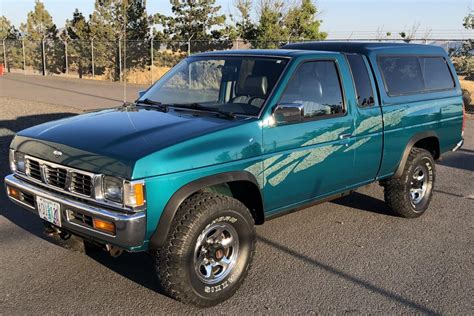Nissan King cab problems

The Datsun Truck is a compact pickup truck made by Nissan in Japan from 1955 through 1997. It was originally sold under the Datsun brand, but this was switched to Nissan in 1983. It was replaced in 1997 by the Frontier and Navara. In Japan, it was sold only in Nissan Bluebird Store locations.
Predecessors
Pre-war
The Datsun truck line began with the Type 13 Truck of April 1934, and was later used as the basis of the Datsun DC-3 roadster. A series of small trucks based on their passenger car counterparts, the 14T, 15T, and 17T, continued to be built until early 1944.
Post-war
The 17T was followed by the post-war Datsun 1121 in 1946, which was nearly identical technically but had an extremely simple body made out of simple pressed metal (with almost no chrome) and many body parts made from wood, to enable production in resource-starved early post-war Japan. Early trucks also depended on leftover stocks of pre-war parts. The engine was the 15 PS (11 kW) Type 7 unit. As the supply situation improved the new 2124 and then 2225 took over in July 1947 and at the end of November of the same year.
A rapid stream of changes and new model numbers followed in this early post-war area, as pre-war parts dried up and new designs were substituted. The naming followed a clear system: the first number represented the chassis/engine iteration, with "1" being the pre-war (17T) design. The second digit was for the bonnet and grille, the third digit for the cab, and the fourth and final digit for the rear body. 1121 thus had mostly pre-war parts, with a post-war design for the cab. The 2225 had post-war chassis and front end designs, with a fourth redesign of the rear bodywork. The grille was a plain, painted pressed steel piece. Some numbers were assigned but never used, such as rear body designs 2 and 3. The 2225 was succeeded by the 2125 at the end of July 1948; this seemingly retrograde step marked the return to the more ornate pre-war 17T grille.
In January 1949 the 3135 took over, followed by the January 1950 3145 model with a slightly different cabin. In August 1950 the Datsun 4146 arrived, introducing the 860 cc Type 10 engine with 15 kW (20 hp; 20 PS). The 4146 also had a bit more chrome trim included, as well as a stronger transmission. The power increase allowed for a somewhat bigger cargo area but top speed only crept up from 67 to 70 km/h (42 to 43 mph).
In 1951 the 5147 appeared, introducing a longer wheelbase of 2,150 mm (84.6 in) rather than the 2,005 mm (78.9 in) chassis which had been used for seventeen years. Most important was the introduction of hydraulic brakes, replacing the original mechanical units. The 5147 was succeeded two years later by the final 6147 model, which received the 25 PS (18 kW; 25 hp) D-10 version of the old sidevalve engine. The extra power output was made possible because of higher quality petrol allowing for higher compression rates. Although somewhat longer and with a bigger engine, the Datsun 6147 remained very similar to the prewar type 15 truck. Payload increased from 500 to 600 kg (1,100 to 1,300 lb) while overall length increased to 3,406 mm (134.1 in). A rare double-cab version, the DU-5, was introduced alongside the 6147. The 6147 was built until the 1955 introduction of the all new 120-series truck.

Social links
Nissan King cab model years


Common Nissan King cab problems
The Nissan King Cab is a popular choice among drivers who need a reliable and versatile vehicle, but like any other vehicle, it has its share of common problems. Here are some of the most frequently reported issues with the Nissan King Cab, based on complaints from owners:
- Air Conditioning System Malfunctions: Owners of the 2013 model year reported issues with the air conditioning system, specifically the air conditioning compressor, which would fail and require replacement. This issue was not reported in other model years.
- Brake Problems: Owners of the 2014 model year reported issues with the brakes, specifically the brake pedal going to the floor and the brake warning light coming on. This issue may be related to the brake system's hydraulic components or the brake warning system.
- Transmission Issues: Some owners reported issues with the transmission, specifically the transmission slipping and making a whining noise. This issue may be related to the transmission's internal components or the transmission fluid.
- Engine Overheating: Miscellaneous issues in the Nissan King Cab can include battery failure, engine overheating, and fuel system malfunctions. Engine overheating may be caused by a variety of factors, including a faulty thermostat, low coolant levels, or a malfunctioning cooling fan.
- Fuel System Malfunctions: Fuel system malfunctions can include issues with the fuel pump, fuel injectors, or fuel pressure regulator. These issues can cause a variety of symptoms, including poor engine performance, difficulty starting the engine, and reduced fuel efficiency.
- Battery Failure: Battery failure can be caused by a variety of factors, including a faulty battery, corroded battery terminals, or a malfunctioning charging system. Symptoms of battery failure can include difficulty starting the engine, dim headlights, and electrical system malfunctions.
It is important to note that these issues may not be exclusive to the Nissan King Cab and can occur in other vehicle models as well. Regular maintenance and timely troubleshooting can help address any issues that may arise and ensure that the vehicle continues to perform optimally.

Are you having problems with your Nissan King cab?


